-
Posted on February 27th, 2017
Brian
Anything that moves is subject to the natural laws of mechanics.
Note; The “Laws of Mechanics” have been in existence since before there was any life in the universe, and are therefore not related to university degrees, Newton, mathematics etcetera.
Electricity is electrons in motion, therefore its energy is in the momentum of the electrons. Can this be true?
Consider ‘static’ electricity. Static is a quantity of electrons constrained to stay in one location. Static normally only occurs on insulators, which do not provide an escape path. Electrons do not like to be close to other electrons (Like charges repel each other), therefore the electrons are in a (compression) stressed condition, each electron pushing against others. The ‘strength’ of the charge depends on the quantity
Note;
If they don’t like each other why don’t they just leave, you may ask? Unfortunately, they need a pathway or a force to escape because they do not have any momentum, they are STATIC. To become electricity they need to be moving. To become heat they need to be moving. To become light they need to be moving.
How do we get them to move? If we move an object that has less ‘static’ electrons slowly towards our original static charge, eventually they will jump across. Whilst they are jumping across they are electricity.
Note; Deserts are a major source of static. The sand is a fairly good insulator and the constant movement of the sand creates a lot of static due to the breakdown of the sand particles releasing electrons.
——————————————–
If light is electrons in motion, why does light not travel down a copper wire?
Light is electrons travelling at very high speed. Copper is highly opaque to light and therefore its energy is reduced into the heat range. Shining a light into a copper wire will cause heat radiation(slow speed electrons).
If light travels easily down a glass rod, why does electricity not travel down it?
A lot more to come on this.
Author – Brian Williams.
-
Posted on November 16th, 2016
Brian
Where does the idea of nuclear fusion come from?
Briefly, it was an hypothesis of Sir Arthur Eddington based on Einstein’s silly formula E = m x c². Eddington’s argument was that “if c² is a constant, then the above formula would indicate that each kilogram (mass) of any material would contain the same energy as a mass of 1 kilogram travelling at a speed of 9,000,000,000 kilometres/second. ( E = 1kg x 300,000 x 300,000)
This idea is typical of the lack of reality in modern physics.
Nuclear fusion is an attempt to unleash this hypothetical energy.
Now E in the formulae E = m x v² ( or even Einstein’s E = m x c²) refers to Kinetic Energy which means the energy required to bring a moving object to rest. If the object is not moving then its kinetic energy is zero.
A 1 kilogram(mass) piece of coal or uranium or cheese resting on a bench has no kinetic energy. The coal, uranium and cheese will each have different amounts of ‘energy’ such as calorific or thermal but no kinetic energy, so the use of of the formulae
Kinetic Energy = mass x velocity², is completely invalid.
Coal and uranium both contain potential energy in the form of atomic stress. I don’t think that cheese does.
Author – Brian Williams.
-
Posted on April 15th, 2016
Brian
Consider the following two statements.
“Photons behave in some ways like particles, little bits of stuff, and in other ways like waves. It’s not just visible sunlight that is made of photons, but a lot of other kinds of waves like radio waves, television broadcasts, x-rays, and the ultraviolet (UVA and UVB) rays that give you sunburns. The difference between light and these other kinds of waves depends on the size of the wave – the wavelength. Very short waves are x-rays and ultraviolet rays, that cause sunburn. Visible light like sunlight is made of medium-length waves. Radio and television waves are very long waves. But all of these rays are made of photons. “ (http://quatr.us/physics/light/photon.htm)
“Wave-Particle Duality in Brief
As mentioned above, light has properties of both a wave and a particle. This was an astounding discovery and is certainly outside the realm of how we normally perceive things. Billiard balls act as particles, while oceans act as waves. Photons act as both a wave and a particle all the time (even though it’s common, but basically incorrect, to say that it’s “sometimes a wave and sometimes a particle” depending upon which features are more obvious at a given time).
Just one of the effects of this wave-particle duality (or particle-wave duality) is that photons, though treated as particles, can be calculated to have frequency, wavelength, amplitude, and other properties inherent in wave mechanics. (http://physics.about.com/od/lightoptics/f/photon.htm)”
From the second statement let us consider “Billiard balls act as particles, while oceans act as waves”.
Oceans do not act as waves any more than than a bowl of jelly or your bath water does. Waves can be created or generated in any substance, from cast iron to gas.
Radio and television waves are man-made generated waves. Sound waves can be generated as in speech or created as in the sound of a falling object but cannot be claimed to prove the wavelike nature of air. Water waves can be either be generated as in the ripple tank or created as by dropping a pebble into a pond but this does not prove the wavelike nature of water. Known waves can be detected in any substance with modern equipment. Hypothetical waves, such as in light have never been detected. Note that in generated light, such as in A/C lighting equipment or strobe lighting, the generated frequency is easily detected, even at high frequencies. This is because light acts like a fluid. in a same way as water or gas.
So let us consider the statement “light has properties of both a wave and a particle”.
Water is made up of particles that we call molecules. Waves can be generated or created in water. Waves can be generated or created in light, (in special circumstances). Light is made up of particles that physicists call photons.
If water molecules do not need to have a wavelike property, why do physicists argue that photons must have a wavelike property? The physicists are rather vague about this. The real reason behind this is because of the physicists argument that (white) light must be composed of all other colours, and requires that individual photons carry particular colour properties. For this, they argue that colour is a waveform, and therefore each photon must have its own individual waveform!
Consider this. You put a new battery into your torch then switch the main room lighting off. You then shine your torch around (say) your child’s playroom. Your new battery is obviously freshly supplied with billions of individual photons that illuminate the thousands of shades and colours.
A photon is actually an electron and it does not have a waveform (or even need one to explain all phenomena of light).
If you shine a light(photons?) onto a photocell you will get electricity (electrons) exiting the photocell. If you connect this to a lamp, light(photons?) will appear. Assuming your initial photocell is powerful enough you can shine this light(photons?) onto another photocell and again produce electricity(electrons). During this process heat (more electrons) is dissipated.
Consider the this from the first statement above, “ It’s not just visible sunlight that is made of photons, but a lot of other kinds of waves like radio waves, television broadcasts, x-rays, and the ultraviolet (UVA and UVB) rays that give you sunburns.”
Like virtually all of modern physics this is opinion only and is not based on evidence.
If this was correct you could produce light from any transmitter that could handle the necessary radio frequencies. You can’t.
All physics can be explained, logically and sensibly, using only two types of particle. More importantly. all physical phenomena can be explained using the oldest scientific laws known to mankind. These are the Laws of Mechanics.
See also-Control experiments for Young’s interference fringes.
Author – Brian Williams
-
Posted on April 14th, 2016
Brian
The mechanics of any thing means how it actually works. Primarily, electromagnetic radiation means movement of electrons by means of a magnetic force. Radio waves can be created by electromagnetic radiation but generally are not. A dynamo creates electricity by using a magnetic field that accelerates electrons. A battery does not produce electricity by magnetics but by chemical reaction. Therefore light from a torch is not electro-magnetic radiation.
The magnetic field generated to move iron filings in school experiments is similar to electro-magnetic radiation in that it moves particles, in this case, iron filings. A single magnetic pulse will move iron filings. a second pulse may move them a little further. further pulses may or may not cause any extra movement.
When a force is momentarily applied to an object and the force is sufficient to move the object, then one of two things will happen. If there is no resisting force acting apart from inertia, then the object will continue moving after the force is removed. In other cases the object will slow down and then stop.
With a magnetic field pulse each step forward reduces the force available to move the object during the next pulse. A magnetic field is not a constant force, the force exerted depends on the distance from the object.
Magnetic fields have a very limited range relative to the force that they can produce. This means that a reversing force field acting on a small mass will lose effective contact with it. The outward force may accelerate the object to a distance beyond reach of the following inward force.
A further point to consider is the ‘velocity’ of the force field. If you consider a paper bag being blown along by the wind, the wind will be travelling faster than the paper bag, (if it wasn’t there would be no force acting on the paper bag and it would fall.). It is assumed that a force field propagates instantaneously. but I am not yet convinced of this, but am unable to put forward a reasonable argument against it. What is certain is that the rate of propagation is faster than 300,000 kilometres per second.
Relating to electrons this means that a magnetic pulse will pass through a cloud of electrons, irrespective of their velocity. This brings in a further complication to an already complex problem.
There is no such thing as ‘instant acceleration’. It takes time to increase a velocity. Even an electron has inertia, plus an electron is subject to resistance from whatever substance that is travelling through.
Author – Brian Williams
-
Posted on April 2nd, 2016
Brian
Why do physicists never do control experiments?
This basic requirement of experimental work is apparently not considered in physics.
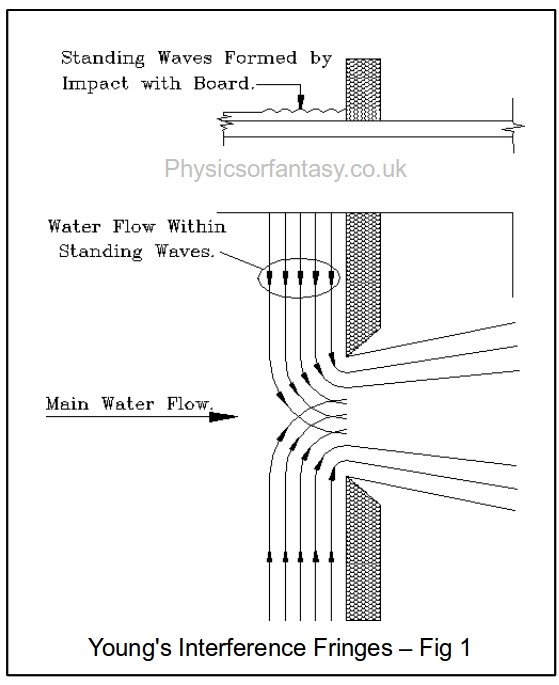
Thomas Young, (1773-1829) carried out various experiments that have ever since been claimed to prove that light has a wave form. His experiments in the early 1800s were based on using experiments with water flow and were claimed to be exactly analogous to sound waves and therefore light. However, we need to fully explore the actual results of these experiments before coming to any rash conclusions.
The above drawing shows water steadily flowing into a barrier that has a slit or gap in it. As the water strikes the barrier a series of standing waves form in front of it. (Yes I know that you have never heard of this before, but they are there but are completely ignored by the physicists, universities and physics teachers). It is easy to check this by using a piece of plastic with a notch cut out of it, and gently running water against it.
These standing waves are created by the mechanics of the experiment and have nothing to do with any inherent wavelike nature of water.
Standing waves do not just stand there without help, they need energy to support them. This energy is supplied by the flow of water within the standing wave. This is a very complex fluid dynamics mechanism. (See. Understanding Waves).
These standing wave forms pass through the slit while still retaining their wave form. Depending on the width of the slit, a cross section of the flow through the slit will show a a series of peaks and troughs THAT WOULD BE ANALOGOUS TO YOUNG’S FRINGES, without indicating that light (or water) had any inherent wavelike nature.
In the drawing below, the lower sketch shows two sets of waves from linked pulsators as used in the Ripple Tank experiments, the origin of Young’s Interference experiments.
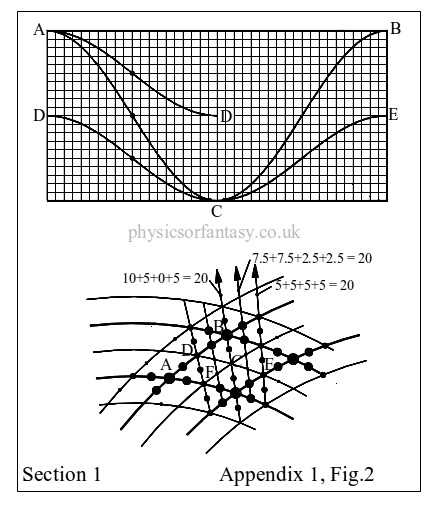
The letters A and B relates to where two wave peaks coincide. The letters D and E relate to where a peak from one wave coincides with the trough from another wave. The arrowed lines identify a path through the waves, and the numbers relate the energy at the points shown along the line for one wave cycle. The figures show that the energy balances out and therefore does not show any fringes.
The problem with these experiments is that they were carried out in the conviction that the wave theory was correct, and any result, however vague, would satisfy the requirement to prove that light was a waveform..
No attempt was made to carry out any control experiments to check if a non-waveform (steady) flow would exhibit fringe-like results. In the ripple tank itself no ‘clear’ fringes are visible.
Note; The assumptions made from these experiments should cause serious concern for human health. The physics establishment has assumed that light operates at frequencies of between 4×1014 Hz (red light) and 8×1014 Hz (violet light). From this they argue that the human body is therefore quite happy to handle ‘electro magnetic’ radiation at these high frequencies. No direct evidence has ever been found indicating that light has waveform or frequency. Since the early 1980s, when I first looked into ‘electro-magnetic’ radiation due to the fact that my computer operated at 1Mhz, I have found no evidence of any form of energy transmission in nature that need electro-magnetics in its operation. The only natural energy transmissions are mechanical (including nerve impulses). The only wavelike energy transmissions in nature are sound and water waves, both mechanical.
‘Electro-magnetic’ pulses such as experienced due to lightning are only a single wavelike occurence, but pulse reflections can set up residual waves.
The Control Experiment for Young’s Fringes.
Below is the set up for the control experiment that I carried out many years ago.
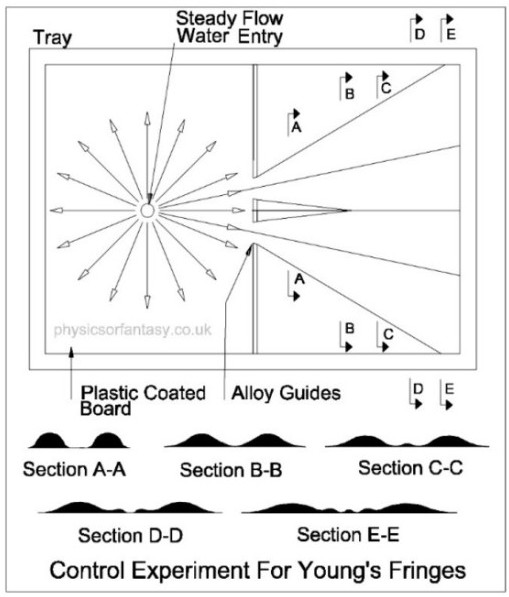
Control Experiment for Young’s Fringes
It should be noted that these standing waves are not directly related to the standing waves in figure 1. In this control experiment the impact waves as created in figure 1 only apply to the separator between the two slits, the water on each side of the slits will tend to run away from the slits due to the angle of water flow. The standing waves from the separator will be much smaller, but may actually help in initially starting the standing waves in this control experiment.
The number of interface standing waves (or fringes) depends on the separation of the slits, the speed of the water and distance from slits. As the distance from the slits increases, so the number of ‘fringes’ increases.
There are numerous examples of this creation of standing waves in fluid dynamics.
Note; My original idea for this experiment was to only have the the central separator but replace the side separators with slots, allowing water to flow freely into the tank. to prevent reflection waves from distorting the results.
This was not satisfactory, but replacing the side separators did highlight the impact standing waves.
Rectilinear Propagation of Light.
This refers to the physicists argument that light always travels in straight lines. This is an very old assumption that is still accepted. Again this is based on water experiments, but as an argument to a ‘crucial difference’ between light and water. In fact, water and light both act strictly in according with the laws of fluid dynamics.
One of the arguments used was that water spreads out after passing through a slot/aperture but light travels in a straight line. It doesn’t. The difference is that water may be travelling at 3metres/second whereas light will be travelling at 300,000,000 metres/second. On earth at the time these arguments originated there was no means of measuring the spread of light. Even today I doubt that it would be possible.
In the drawing below the left hand sketch shows what happens when light passes through an orifice.
Note that the colour bands are determined by the eye/brain and are not actually a part of light. Not an easy idea to comprehend, I know, but see ( origin-of-colour ).
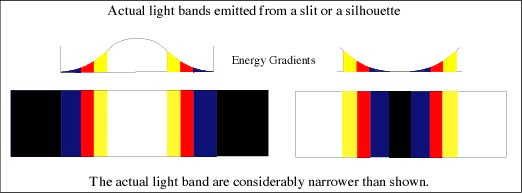
Light passing through an orifice conforms to the same fundamental fluid dynamic principles as water passing through an orifice. It is slowed down at the edges. The light exiting the orifice close to the edge will have its linear velocity reduced most. It does not, however lose all its energy. Some is retained in spin and some in deviation. However, the eye only relates to the linear velocity entering it. This velocity determines the colour perceived by the brain. Note that true Blue is a very dark blue and is difficult to see compared to the white and yellow. This is generally considered to be ‘infra-red’, but in fact is low ‘velocity’ light.
Basically light is a form of energy composed of particles that have no colour. ‘Colour’ is defined by the energy of the particles that arrive at the ‘colour’ receptors in the eye. The sensation of ‘colour’ is created by the brain itself. The human brain/eye combination allocates four energy ranges that correspond with the sensations of Blue, Red, Yellow and White. Other lifeforms may use a different number of ranges to suit their own evolutionary requirements.
This light spreads out in a similar way as my ‘control experiment’, and in the double slit situation creates an interface which creates standing waves. These standing waves still contain most of the energy lost in ‘velocity’.
In the drawing below (slightly over-cropped on the left), I have shown two separate light sources. This not a mistake, it is to make a deliberate point that Youngs Interfence Fringes still occur with totally different light sources without needing a single source to supply two synchronised light beams.
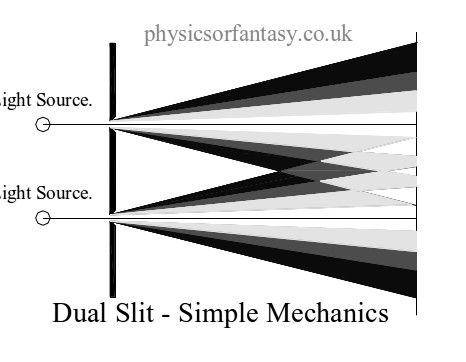
Dual Slit – Simple Mechanics
The shaded areas indicate the energy levels, pale grey being high energy, mid grey being mid energy and dark grey being low energy. The white areas on the right and centre lines indicate highest energy levels. Where these energy areas cross each other the energy level jumps into the higher energy band. However, fluid mechanics is a lot more complex than this, there is large amount of activity happening at the same time. See also (Taper Slit Experiment)
As the two streams(or beams if you like) meet, the forward velocity increases. In light this means that the low velocity light (or infra-red if you are a physicist) is forced to increase its velocity, bringing it into the visible range.
As the two beams continue to move in together the energy in the central area increases and the velocity increases.
In a similar way to the water dual slits as shown earlier, ‘standing waves’ are created. They don’t actually stand but are created in the same way, being relatively slow sideways moving pressure ridges. These pressure ridges are the source of Young’s Interference Fringes and have nothing to do with any wave like nature of light.
The eye has a threshold level due to energy loss in the vitreous humour, the eyeball ‘filling’. The energy of the light (velocity) is reduced so that the lower velocity particles do not even reach the retina. This prevents the brain from seeing ‘energy’ that instruments can detect, such as the ‘infra-red’ claimed by the physicists.
Young’s interference fringes are truly the only ‘evidence?’ for the claim for the wave theory of light but is clearly based on very poor experimental techniques.
Fluid dynamics is the most difficult subject I have ever studied. I will try to produce a more meaningful drawing in the next few days.
See also;- What is a Photon?
More to come on this later.
Author- Brian Williams
-
Posted on March 23rd, 2016
Brian
Why do physicists never do control experiments?
This basic requirement of experimental work is apparently not considered in physics.

Thomas Young, (1773-1829) carried out various experiments that have ever since been claimed to prove that light has a wave form. His experiments in the early 1800s were based on using experiments with water flow and were claimed to be exactly analogous to sound waves and therefore light. However, we need to fully explore the actual results of these experiments before coming to any rash conclusions.
The above drawing shows water steadily flowing into a barrier that has a slit or gap in it. As the water strikes the barrier a series of standing waves form in front of it. (Yes I know that you have never heard of this before, but they are there but are completely ignored by the physicists, universities and physics teachers). It is easy to check this by using a piece of plastic with a notch cut out of it, and gently running water against it.
These standing waves are created by the mechanics of the experiment and have nothing to do with any inherent wavelike nature of water.
Standing waves do not just stand there without help, they need energy to support them. This energy is supplied by the flow of water within the standing wave. This is a very complex fluid dynamics mechanism. (See. Understanding Waves).
These standing wave forms pass through the slit while still retaining their wave form. Depending on the width of the slit, a cross section of the flow through the slit will show a a series of peaks and troughs THAT WOULD BE ANALOGOUS TO YOUNG’S FRINGES, without indicating that light (or water) had any inherent wavelike nature.
In the drawing below, the lower sketch shows two sets of waves from linked pulsators as used in the Ripple Tank experiments, the origin of Young’s Interference experiments.

The letters A and B relates to where two wave peaks coincide. The letters D and E relate to where a peak from one wave coincides with the trough from another wave. The arrowed lines identify a path through the waves, and the numbers relate the energy at the points shown along the line for one wave cycle. The figures show that the energy balances out and therefore does not show any fringes.
The problem with these experiments is that they were carried out in the belief that the wave theory was correct.
No attempt was made to carry out any control experiments to check if a non-waveform (steady) flow would exhibit fringe-like results. In the ripple tank itself no ‘clear’ fringes are visible.
Note; The assumptions made from these experiments should cause serious concern for human health. The physics establishment have assumed that light operates at frequencies of between 4×1014 Hz (red light) and 8×1014 Hz (violet light). From this they argue that the human body is therefore quite happy to handle ‘electro magnetic’ radiation at these high frequencies. No direct evidence has ever been found indicating that light has waveform or frequency. Since the early 1980s, when I first looked into ‘electro-magnetic’ radiation due to the fact that my computer operated at 1Mhz, I have found no evidence of any form of energy transmission in nature that need electro-magnetics in its operation. The only natural energy transmissions are mechanical (including nerve impulses). The only wavelike energy transmissions in nature are sound and water waves, both mechanical.
The Control Experiment for Young’s Fringes.
Below is the set up for the control experiment that I carried out many years ago.
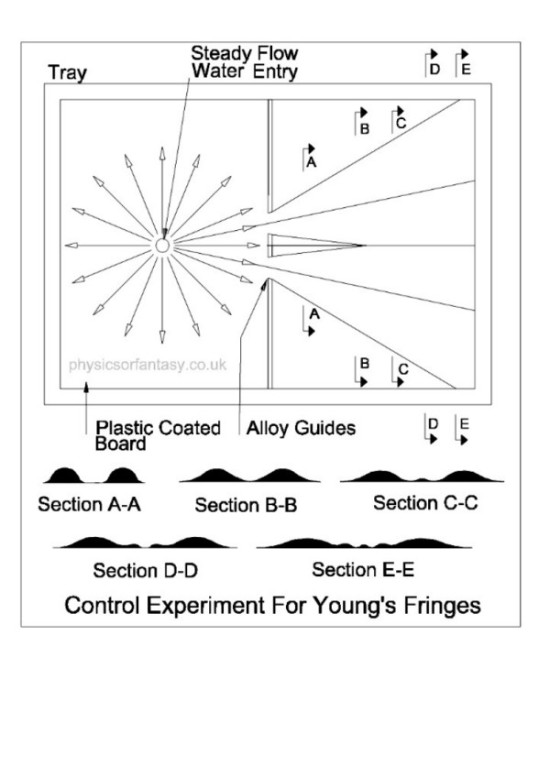
It should be noted that these standing waves are not directly related to the standing waves in figure 1. In this control experiment the impact waves as created in figure 1 only apply to the separator between the two slits, the water on each side of the slits will tend to run away from the slits due to the angle of water flow. The standing waves from the separator will be much smaller, but may actually help in initially starting the standing waves in this control experiment.
The number of interface standing waves (or fringes) depends on the separation of the slits, the speed of the water and distance from slits. As the distance from the slits increases, so the number of ‘fringes’ increases.
There are numerous examples of this creation of standing waves in fluid dynamics.
More to come on this later.
Author- Brian Williams
-
Posted on January 19th, 2016
Brian
The following drawing shows the basic mechanics relating to shaking a baby. Surprisingly, the total shaking movement of the child’s body, to and fro, is only about 6″ (150mm). Just try it and see, (but not on a real child, please) and you will find it difficult and uncomfortable to make it more than that. You should also realise that it’s the child’s body that is shaken, not it’s head.
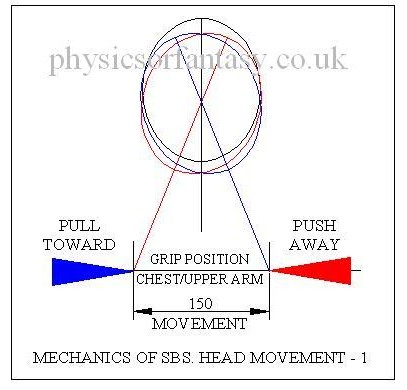
As the head is not rigidly fixed to the body it does not move this same 6″ but moves up and down by a few millimetres and also rotates by about 20º each side of the vertical, the neck bending to allow this to happen. There are only small acceleration forces acting on the head. Basically, the body moves relative to an almost stationary head
The inertia of the child’s head restricts any rapid movements to it. Any movements of the head can only be caused by forces acting through the neck, which is very flexible. Any serious movements to the head would cause serious damage to the spine which is just as fragile as the brain.
The following drawing refers to the auxiliary head movements that should also be considered.
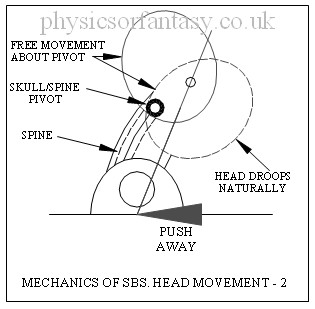
The relatively free ‘nodding’ movement of the head is entirely consciously controlled by muscles in the neck. If you fall asleep your head will freely fall backwards, sideways or forward. Undue accelerations in this movement would likely cause neck muscle and tendon damage plus damage to the complex pivot assembly because in the SBS case the child is assumed to be awake. However, these same injuries could also happen during the birth process.
I sent data to the Louise Woodward defence team relating to the mechanics of Shaken Baby Syndrome in 1997.
Anyone who watched the case on television, after the defence team brought in a specialist engineer, must have been amazed by the prosecution attorney’s ridiculous antics whilst attempting to show how the head could be held in such a way that it was shaken along with the body. She had obviously spent a lot of time thinking about this, but the contortions she got into made it obvious that Louise Woodward could never have carried out the same rigmarole in a fit of anger.
———————————–
Abstract.
Dynamic Biomechanical Findings on Shaken Baby Syndrome/Lethal Minor Falls
http://sbsreferences.com/DownloadHandler.ashx?pg=392f9051-f6fa-4a54-a2d8-70157cf253c0§ion=11dab90f-171c-4263-9334-b175c406f533&file=Exhibit+14A.pdf
FROM: Injury Biomechanics Researcher: Chris Van Ee, PhD
TO: The Honorable Court
SUBJECT: Dynamic Biomechanical Findings on SBS-LMF
DATE: March 3, 2008
Dynamic Biomechanical Findings March 7, 2008 Page 2 of 4
2. SBS/LMF Findings From Biomechanical Tests and Studies:
(A) Scientific testing has shown that head acceleration levels from anterior/posterior human shaking of a normal 0- to 2-year-old child in the sagittal plane results in head acceleration and force levels that are much lower than those which are associated with traumatic head injury. Repeated testing of this hypothetical has shown that the head accelerations associated with shaking are far below the level associated with injury and there is no quality data to support the SBS brain injury mechanism. Thus shaking, even if done in a fit of anger, is not expected to result in head dynamics sufficient to cause direct intracerebral trauma.
(B) Human shaking (id.) may cause lethal brain stem and cervical spine injuries in a 0-to 2-year-old child, as the forces necessary for these injuries are well below the level needed for fatal brain injuries and are consistent with the forces that can be produced in shaking. Put another way, these neck injuries would be expected in any hypothetical-superhuman-strength case of SBS where superhuman dynamics resulted in head accelerations leading to intercerebral trauma (if SBS were valid, which it is not).
————————————–
Abstract from
Shaken baby syndrome: A biomechanics analysis of injury mechanisms.
Traumatic infant shaking has been associated with the shaken baby syndrome (SBS) diagnosis without verification of the operative mechanisms of injury. Intensities for SBS have been expressed only in qualitative, unsubstantiated terms usually referring to acceleration/deceleration rotational injury and relating to falls from great heights onto hard surfaces or from severe motor vehicle crashes. We conducted an injury biomechanics analysis of the reported SBS levels of rotational velocity and acceleration of the head for their injury effects on the infant head-neck. Resulting forces were compared with experimental data on the structural failure limits of the cervical spine in several animal models as well as human neonate cadaver models. We have determined that an infant head subjected to the levels of rotational velocity and acceleration called for in the SBS literature, would experience forces on the infant neck far exceeding the limits for structural failure of the cervical spine. Furthermore, shaking cervical spine injury can occur at much lower levels of head velocity and acceleration than those reported for the SBS. These findings are consistent with the physical laws of injury biomechanics as well as our collective understanding of the fragile infant cervical spine from (1) clinical obstetric experience, (2) automotive medicine and crash safety experience, and (3) common parental experience. The findings are not, however, consistent with the current clinical SBS experience and are in stark contradiction with the reported rarity of cervical spine injury in children diagnosed with SBS. In light of the implications of these findings on child protection and their social and medico-legal significance, a re-evaluation of the current diagnostic criteria for the SBS and its application is suggested.
Faris A. Bandak. Department of Neurology, A1036 F. Edward Hébert School of Medicine, Uniformed Services, University of the Health Sciences, Bethesda, MD 20814, USA
—————————-
Abstract from Wikapedia/cheshire nanny case (Louise Woodward Trial. 1967)
Patrick Barnes, a pediatric radiologist at Stanford University, was a key prosecution witness in the trial, but in 2011 said he would not give the same testimony today. He said there had been a revolution in the understanding of head injuries in the past decade, partly due to advances in MRI brain scanning technology: “We started realizing there were a number of medical conditions that can affect a baby’s brain and look like the findings that we used to attribute to shaken baby syndrome or child abuse”, such as infections and in utero strokes.
—————————-
MORE TO FOLLOW SHORTLY.
Author – Brian Williams
Read also; Shaken Baby Syndrome-Debunking the Myth
Shaken baby syndrome: A biomechanics analysis of injury mechanisms
-
Posted on January 16th, 2016
Brian
Magnetism is a very weak version of the nuclear force. It is caused by creating a very small shift in the position of the nuclei in the atoms. Obviously this can only happen if atoms have a crystal like structure.

Nuclei Shift in Magnetics
Obviously the above is a very simplified example.
Permanent magnets need a mixture of atoms to allow the more stable atoms to lock the more susceptible atoms (say iron) into a permanent magnetic state.
Author – Brian Williams.
See How to Built an Atom
-
Posted on January 2nd, 2016
Brian
Birth Brain Injuries
1. What is a ‘normal’ birth?
Figures given in ‘ESSENTIAL OBSTETRICS & GYNAECOLOGY’ (E.O.G.) Chapter 17, indicate that 6.7% of live births in England & Wales are Low Birth Weight i.e. less than 2.5 kilograms.
From the same chapter we are told that the common causes of death in the 1st 4 weeks of life are;
1. Major congenital abnormalities incompatible with life.
2. Prematurity- the most important single factor in causing neonatal death, associated with,
a. Respiratory Distress Syndrome.
b. Pnuemonia.
c. Intercranial Haemorrhage and cerebral damage sustained either during labour and delivery or in the early neonatal period.
d. Necrotizing enterocolitus.
From NEONATAL NEUROLOGY page 139, we are told that ” Levene and Starte (1981) studied 202 consecutive admissions of all birth weights, 68 (34%) of whom were found to have intracranial haemorrhage”
From NEONATAL NEUROLOGY page 76, we are told that approx. 27% of premature infants born in the 31st to 34th weeks develop Periventricular haemorrhages.
From NEONATAL NEUROLOGY ,page 63, we are told that approx. 7% of premature infants born with a birth weight of 1.8 kilograms or less have subarachnoid haemorrhage.
From NEONATAL NEUROLOGY page 57, we are told that ” Intracranial haemorrhage occurs commonly in newborn infants and is an important cause of death & handicap.”
It is evident therefore, that brain haemorrhages in infants is common.
It is also a well documented fact that due to the lack of development of the blood vessels the premature infant is at an increased risk of haemorrhage.
Subdural Haematomas.
From NEONATAL NEUROLOGY, page 58, we are told that “the cause of this type of condition is usually traumatic, that the incidence of it has greatly reduced over recent years and that It has not however, completely disappeared; indeed it may still be a relatively common lesion affecting the neonatal brain and may be associated with few clinical signs, thus remaining undiagnosed during life.”
I need to tidy up the following two graphics and information on originators. Brian.
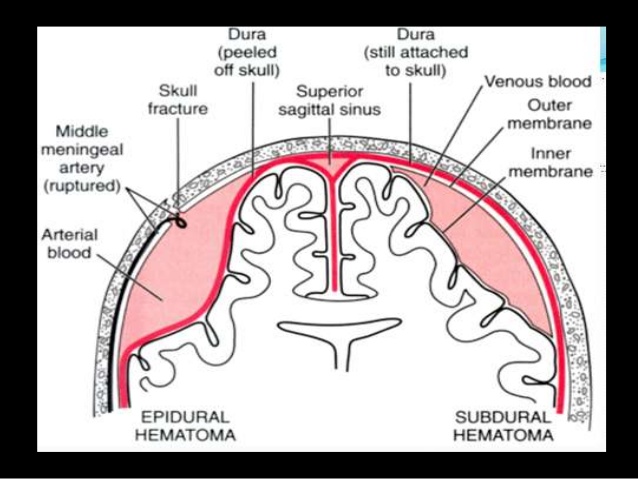
Intracranial Haemorrhages
Note the difference between the following two sets of statements referring to the cause of subdural haemorrhages.
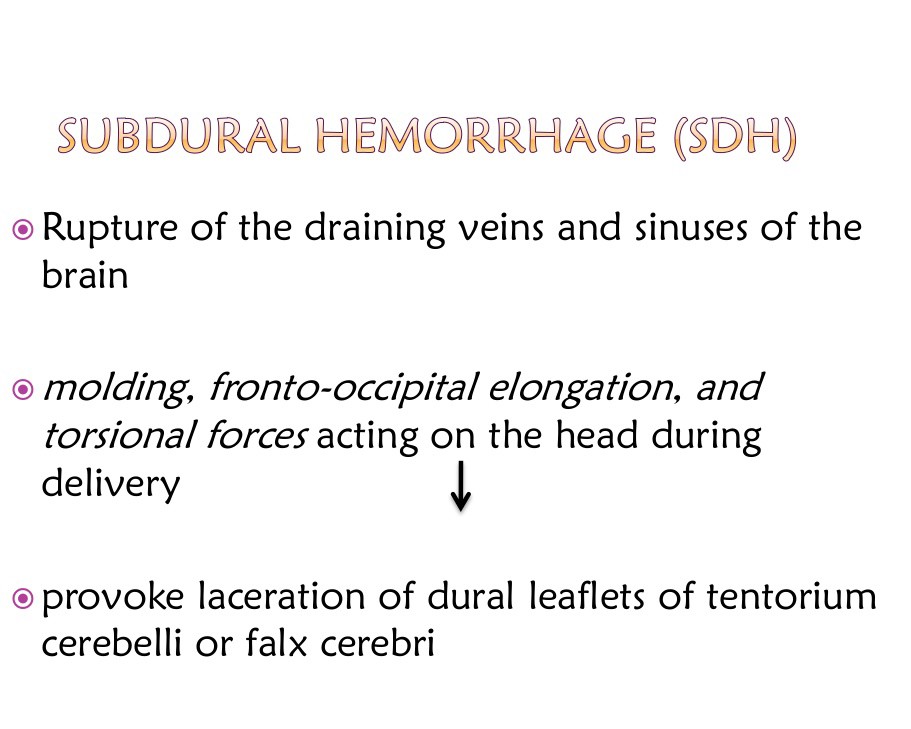
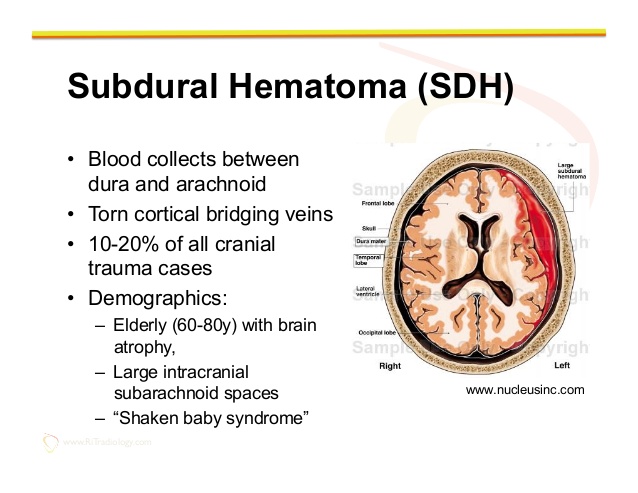 The first is a bit confusing (like most medical literature) but I read this as 1. Actual damage to the head. 2. Caused by distortion of the brain during the birth process.
The first is a bit confusing (like most medical literature) but I read this as 1. Actual damage to the head. 2. Caused by distortion of the brain during the birth process.
The second set of statements is also slightly confusing, but I read this as “Blood collects between the dura and arachnoid layers, due to torn veins. Subdural Haematomas comprise 10 – 20% of all cranial trauma cases.
The three main causes of the torn veins is 1. Brain atrophy in the elderly. 2. Large intracranial subarachnoid spaces.
3. “Shaken Baby Syndrome”.
Relating to demographics, it should read. 1. Elderly people with brain atrophy. 2. People with large intracranial subarachnoid spaces. 3. “Shaken Baby Syndrome” is not a demographic type.
There can be many causes of subdural haemotomas to people who are not between the ages of 60-80 with brain atrophy, or people who have large intracranial subarachnoid spaces.
Falls can occur to people of all ages. Are the paediatricians really asking us to believe, that subdural Haematomas only happen to the people mentioned in the above two demographic categories plus babies that are shaken or thrown about? If a 30year old man falls off a ladder, are the paediatricians saying that the man cannot suffer from a subdural Haematomas due to falling?
In the drawing below there are numerous large and small veins shown. During the birth process the head can get quite seriously distorted, because at this stage the skull is quite soft and pliable to enable the head to pass through the birth canal.
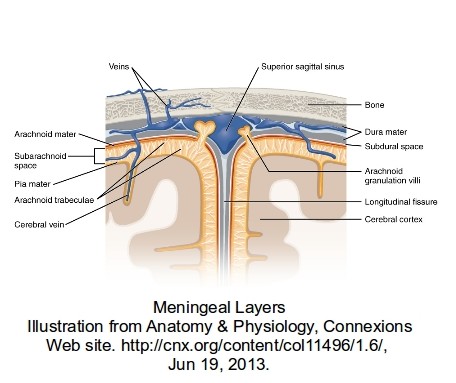 Excluding any accelerations or decelerations (obviously not applicable during the birth process unless the paediatrician is (non-accidentally) shaking the mother or throwing her onto the floor), the main stresses are distortions to the head caused primarily by the natural pressure of the birth process working against the restriction of the birth canal. It should be remembered that the skull is not bone at this stage, and although giving some protection to the brain, is not a crash helmet. In the area of the fontanelle, the very soft area of the skull in babies, the brain is virtually unprotected.
Excluding any accelerations or decelerations (obviously not applicable during the birth process unless the paediatrician is (non-accidentally) shaking the mother or throwing her onto the floor), the main stresses are distortions to the head caused primarily by the natural pressure of the birth process working against the restriction of the birth canal. It should be remembered that the skull is not bone at this stage, and although giving some protection to the brain, is not a crash helmet. In the area of the fontanelle, the very soft area of the skull in babies, the brain is virtually unprotected.
Squeezing of the brain tends to to force it forward and bulge into the fontanelle area, but being restrained by the dura-mater. This will cause stretching on the inside of the dura-mater that can damage veins and capillaries that then bleed into the subdural space.
Obviously there are many things to consider; Is it a rapid/easy birth or an extended/complicated birth? Is it a full term baby or premature? How much external handling of the birth was required?
The birth process is not a guaranteed simple process especially in a first birth for the mother. The mother’s natural anxiety with her first birth can complicate the process. The mother’s anatomy can have a great effect on the birth process.
Jaundice Causes
By Mayo Clinic Staff
Excess bilirubin (hyperbilirubinemia) is the main cause of jaundice. Bilirubin, which is responsible for the yellow color of jaundice, is a normal part of the pigment released from the breakdown of “used” red blood cells.
Normally, the liver filters bilirubin from the bloodstream and releases it into the intestinal tract. A newborn’s immature liver often can’t remove bilirubin quickly enough, causing an excess of bilirubin. Jaundice due to these normal newborn conditions is called physiologic jaundice, and it typically appears on the second or third day of life.
Other causes
An underlying disorder may cause jaundice. In these cases, jaundice often appears much earlier or much later than physiologic jaundice. Diseases or conditions that can cause jaundice include:
-
Internal bleeding (hemorrhage)
-
An infection in your baby’s blood (sepsis)
-
Other viral or bacterial infections
-
An incompatibility between the mother’s blood and the baby’s blood
-
A liver malfunction
-
An enzyme deficiency
-
An abnormality of your baby’s red blood cells that causes them to break
—————————————
From. wikipedia.org/wiki/Shaken_baby_syndrome/legal issues
In 2012, Dr. A. Norman Guthkelch, the neurosurgeon often credited with “discovering” the diagnosis of SBS,[54] published an article “after 40 years of consideration,” which is harshly critical of shaken baby prosecutions based solely on the triad of injuries.[55] Again, in 2012, Dr. Guthkelch stated in an interview, “I think we need to go back to the drawing board and make a more thorough assessment of these fatal cases, and I am going to bet . . . that we are going to find in every – or at least the large majority of cases, the child had another severe illness of some sort which was missed until too late.”[56] Furthermore, in 2015, Dr. Guthkelch went so far as to say, “I was against defining this thing as a syndrome in the first instance. To go on and say every time you see it, it’s a crime…It became an easy way to go into jail.”[57]
On the other hand, Teri Covington, who runs the National Center for Child Death Review Policy and Practice, worries that such caution has led to a growing number of cases of child abuse in which the abuser is not punished.[54]
This is a rather nasty statement (by Teri Covington) to make. She is implying that irrespective of the evidence, the people charged with SBS are actually the abusers. Brian.
———————————–
More to follow
——————————————
Author; Brian Williams.
-
Posted on December 22nd, 2015
Brian
The original “Shaken Baby Syndrome” was a logical and sensible set of guide lines. These were changed over the years to include injuries that previously were known and accepted as birth injuries. Over the last 20 years these later, suspect, injuries have virtually replaced the original guide lines, and in the majority of ‘ Shaken Baby’ cases there is no evidence that indicates that shacking has taken place. I originally became involved in this problem in 1996 and supplied some data to the “Cheshire Nanny, Louise Woodward” defence team. (I watched a considerable amount of the court proceedings and in my opinion the court case was a legal and medical fiasco.)
Note that the accelerations claimed by paediatricians to cause bleeding in the brain, cannot be obtained by shaking without damage to the neck. Basic mechanics, not a subject understood by them.
Brian.
SEE MORE ON THIS SUBJECT ON THIS WEBSITE:
The Mechanics of the Shaken Baby Syndrome
Birth Brain Injuries
External injuries and disappearing bruises
Strange statements made by medical experts
Expert Witnesses.
Shaken Baby Syndrome and the Justice System.
Retinal Haemorrhages.
Shaken Baby Syndrome facts and fallacies.
————————————————
From the Daily Telegraph 22nd December 2015
Dr Waney Squier, a paediatric neuropathologist, is due to appear before the General Medical Council (GMC) tomorrow accused of “bias” and “dishonesty” after disputing the existence of “shaken baby syndrome” in a number of court cases.
For decades, the pathologist, who works at the John Radcliffe Hospital, Oxford, appeared as a prosecution witness against parents accused of killing their children.
She argued that a combination of three brain injuries — swelling of the brain, bleeding between the skull and brain and bleeding in the retina — was sufficient to determine that the death resulted from a child being violently shaken.
But more than a decade ago, amid the emergence of research disputing the mainstream theory, Dr Squier had a change of heart, becoming convinced that such symptoms were not conclusive.
Fearing that reliance on the argument had led to miscarriages of justice, she became a key expert witness defending parents who said their children’s deaths were the result of natural tragedies.
The case opening tomorrow could see Dr Squier, a pathologist for more than 30 years, removed from the medical register, for the opinions she has expressed in court.
The charges against her — of which few details have been released — have shocked several medical and legal specialists, who believe the action stems from a campaign to silence doubts about the theory, and secure more convictions for child murder.
Dr Marta Cohen, a paediatric pathologist at Sheffield Children’s Hospital who shares Dr Squier’s views, said: “I believe this humble, clever, courageous woman is the victim of a witch hunt by the Metropolitan Police to stop her from being an expert witness which may risk them losing their case.”
Dr Squier, 66, has devoted almost all of her professional life to the study of infant brains, appearing in courts around the world in cases where babies had died after suffering brain injury. In the UK, around 250 cases involving claims of shaken baby syndrome go to court a year.
Until 2001, she agreed with the standard medical view that the combination of three key symptoms, known as the “triad”, should lead to a conviction. But subsequent research led her to doubt that these symptoms alone were sufficient verification of guilt.
She came to believe that shaken baby syndrome may not exist, and that the triad signs could occur naturally in a baby. Dr Squier suggests that bleeding into the membranes in the brain could be a mechanism in young babies, which is intended to protect the brain itself from haemorrhage as it is exposed to pressure during delivery.
The view, shared by a minority of pathologists, is at odds with mainstream theories developed in the 1970s.
In 2000, Lorraine Harris, of Derbyshire, was jailed for manslaughter, after Dr Squier concluded her four-month-old baby Patrick had been shaken to death. But in a 2005 appeal, the pathologist was called as an expert witness for the defence, saying she was now convinced the criteria she had used to define whether shaken baby syndrome had occurred were wrong. The conviction was quashed.
Around the world, the arguments became heated. The case of British nanny Louise Woodward — found guilty in 1997 of shaking eight-month-old Matthew Eappen to death in Boston, Massachusetts — was pivotal in bringing arguments over shaken baby syndrome into the public eye. She was jailed for 15 years but the conviction for second degree murder was later reduced to involuntary manslaughter.
Dr Squier became the target of criticism. This culminated in a 2009 case in which a High Court judge, Justice Eleanor King, accused her of speaking “contrary to the mainstream of current thinking”. As a result, in April 2010, police referred the doctor to the GMC. Around the same time, Scotland Yard police are alleged to have undermined the pathologist and other expert witnesses blamed for failure to convict in cases of shaken baby syndrome.
At a US conference in 2010, Det Insp Colin Welsh, then of the Met’s child abuse investigation command, was reported to have suggested police would investigate such experts and report them to their professional bodies “to see if we turn up anything”.
Since then, the pathologist has been rejected by a number of courts. In 2011, Dr Squier said: “If I am blocked from giving evidence in court, defendants already having to cope with the tragic death of a baby will not get the benefit of the new science. Equally, if the courts fail to accept that the mainstream view of 30 years ago can no longer be relied upon, there will be serious miscarriages of justice.”
The pathologist said many convictions for shaken baby syndrome relied on confessions. “Some police grind those accused down interviewing them for hours while their baby is dying in hospital,” she said. “Under such duress people can confess to anything.”
Tomorrow, a GMC fitness to practise panel will consider charges that between 2007 and 2010, the pathologist failed to be “objective and unbiased”, was “dishonest”, and “brought the reputation of the medical profession into disrepute” while acting as an expert witness in court cases.
Last week, the GMC had yet to pass on to the pathologist’s lawyer full details of her alleged dishonesty. Dr Squier said: “I refute the charges absolutely. I will be putting up a very robust defence but I am unable to discuss it further at the moment.”
If she is cleared, it could throw the findings of thousands of cases into question.
Prof Margaret Esiri, emeritus professor of neuropathology at the University of Oxford, who has worked with Dr Squier since the 1980s, said: “Her findings do make it more difficult for the police to prosecute. They would rather evidence was cut and dried so they can get their convictions.”
Bill Bache, a solicitor who has defended families in cases where shaken baby syndrome was alleged, said he was “flabbergasted” by the charges.
Clive Stafford Smith, a civil rights lawyer and director of the charity Reprieve, said: “Much shaken baby and battered child testimony is extremely dubious, and should be vigorously questioned.”
The Medical Practitioners Tribunal Service, which manages such GMC hearings, declined to comment. The Metropolitan Police said: “We are aware of a report registered by the then National Police Improvement Agency with the GMC in 2010 about a doctor. The Metropolitan Police cooperated with a request from the GMC to provide relevant information.”
See also-
The Mechanics of the Shaken Baby Syndrome
Birth Brain Injuries
External injuries and disappearing bruises
Strange statements made by medical experts
Expert Witnesses.
Shaken Baby Syndrome and the Justice System.
Retinal Haemorrhages.
Shaken Baby Syndrome facts and fallacies.
-














